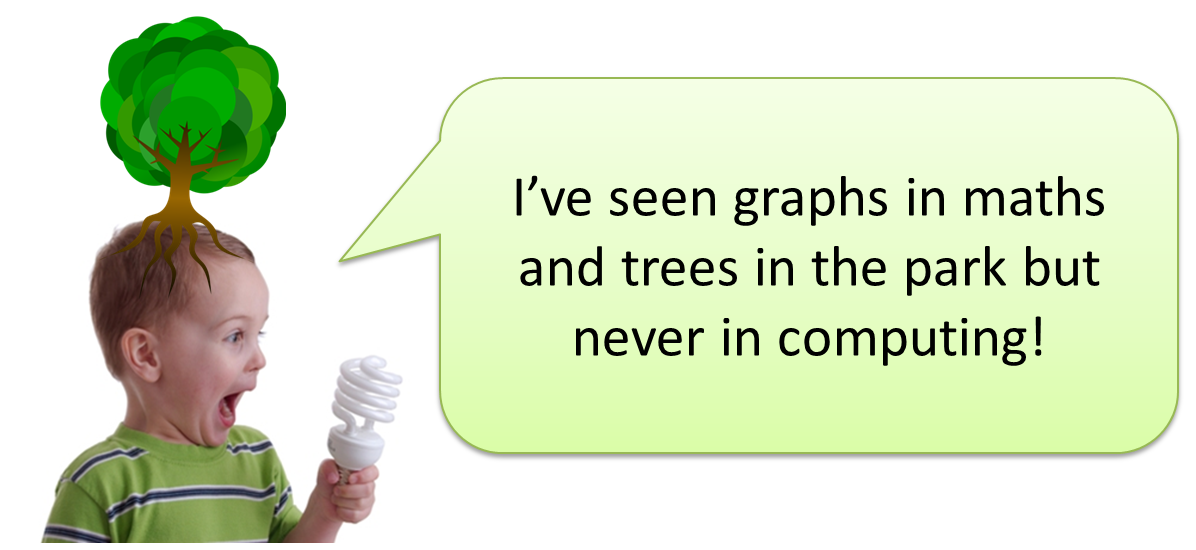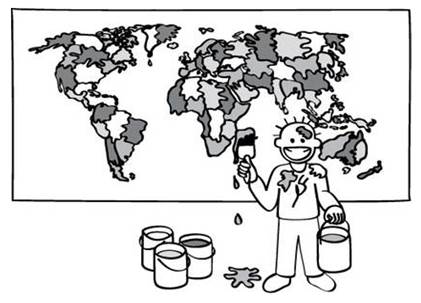s5cs43 graphs and trees
What have graphs and trees got to do with computing?

In this section we will consider two very important data structures - graphs and trees.
We are learning ...
About graphs
About trees
About traversal algorithms
So that we can ...
Represent graphs as data structures
- representing complex relationships
- typical uses
- terms
Represent graphs
- Adjacency matrix and adjacency list
- Advantages and disadvantages of both
Apply breadth first and depth first graph traversal algorithms and describe typical applications of both
- depth first : navigating a maze
- breadth first : shortest path for unweighted graph
Describe and represent trees
- Connected, undirected graph with no cycles
- Rooted tree where every vertex is directed away from the root
Describe binary trees
- Binary tree (rooted tree with <= 2 children per node)
- Representing binary trees using pointers
- Typical uses
Trace tree traversal algorithms and their applications
- pre-order
- in-order
- post-order
Describe and implement route / pathfinding algorithms
- Dijkstras shortest path algoritm
- A* algorithm
Way back in the AS part of the course, we met the 'Poor cartographer' - a problem in graph colouring. We actually used a game called Floodfill (which I'm not expecting you to play now, but you probably will!) A solution to this problem involves drawing graphs - connected diagrams which are used, in this case, to represent barred relationships between areas to be coloured. Using this data structure and a particular algorithm, we were able to deduce a solution (though not always optimal) to the problem.


Task 1.1 The Ichthyophile Problem
A particularly enthusiastic, but poor, aquarium owner wishes to house eight different kinds of fish, however some fish can't be stored with others because they will eat them ...
Shark eat kipper, minnow and piranha;
Kipper eat goldfish;
Minnow don't eat any other fish;
Tuna eat minnow;
Salmon eat minnow and tuna;
Piranha eat tuna, kipper, salmon and minnow;
Goldfish don't eat any other fish;
Swordfish eat minnow and tuna.
How can we organise the fish into tanks such that no fish who eat each other occupy the same tank? What is the minimum number of tanks that we need? Which fish are in which tanks?
OUTCOME : No checkpoint, just a reminder of one application of graph theory.

Binary tree implementation
using System;
class TreeNode
{
public int data;
public TreeNode left, right;
public TreeNode(int data)
{
this.data = data;
left = null;
right = null;
}
}
class BinaryTree
{
public TreeNode root;
public BinaryTree()
{
root = null;
}
public void Insert(int data)
{
root = Insert(root, data);
}
private TreeNode Insert(TreeNode node, int data)
{
if (node == null)
{
node = new TreeNode(data);
}
else if (data < node.data)
{
node.left = Insert(node.left, data);
}
else
{
node.right = Insert(node.right, data);
}
return node;
}
public void Traverse()
{
Traverse(root);
}
private void Traverse(TreeNode node)
{
if (node != null)
{
Traverse(node.left);
Console.Write(node.data + " ");
Traverse(node.right);
}
}
}
class Program
{
static void Main(string[] args)
{
BinaryTree tree = new BinaryTree();
tree.Insert(5);
tree.Insert(3);
tree.Insert(8);
tree.Insert(1);
tree.Insert(4);
tree.Insert(7);
tree.Insert(9);
Console.WriteLine("Tree traversal:");
tree.Traverse();
}
}This implementation defines two classes:
TreeNodeBinaryTreeTreeNodedataleftrightBinaryTreerootThe
BinaryTreeInsertTraverseInsertTraverseIn the
MainBinaryTreeTree traversal:
1 3 4 5 7 8 9...which shows that the nodes have been inserted into the tree correctly and that the traversal algorithm is working.
Last modified: February 14th, 2024






















